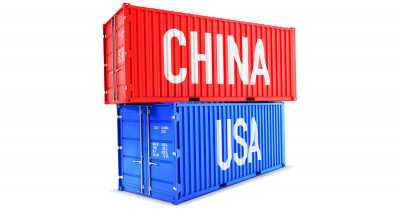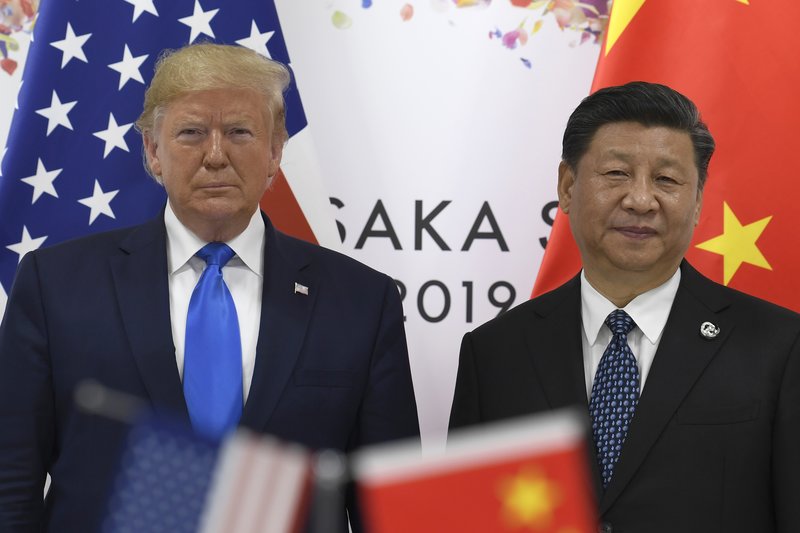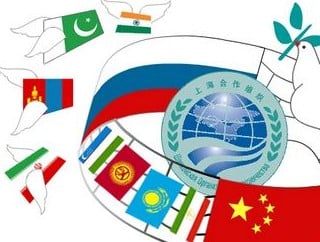China’s Challenge to American Power?

By the year 1918, Great Britain’s once far-reaching empire was crumbling, with the rate of British decline increased by her hugely expensive and unnecessary involvement in World War I. The United States, meanwhile, was taking over Britain’s mantle as the planet’s strongest nation.
America would not reach the status of a true global power until resumption of hostilities during World War II. Come the summer of 1945, with the Axis powers in ruins and defeated, America had become by far the most powerful country in history, possessing about 50% of the world’s wealth.
The high point of US supremacy would not last for long, however. America’s decline began not in recent years, as is sometimes thought, but in fact seven decades ago. During early October 1949, America “lost China to communism” when Mao Zedong successfully led a revolution against the Western-backed leader Chiang Kai-shek and his supposedly nationalist party, the Kuomintang.
In December 1949, Chiang Kai-shek along with thousands of his followers fled to the island of Taiwan, located a few hundred miles off China’s south-eastern coast.
US president Harry Truman had refused to send American army personnel to bolster Chiang Kai-shek’s increasingly corrupt and unpopular regime. President Truman wrote as early as November 1945 that, “We are not mixing in China’s internal affairs”, from a direct military viewpoint at least.
China’s takeover by communist factions was viewed as a catastrophe by political figures in Washington. They also feared close collaboration between China and the USSR, which could inflict untold harm on American interests in the eastern hemisphere.
 China is situated in a strategically vital area of east Asia – with Russia lying northwards, resource-laden central Asia to the west, Korea and Japan to the east. China is also a state rich in valuable deposits like coal, natural gas, aluminium and magnesium. Western business had flourished in China during the years before World War II, much to the detriment of the Japanese.
China is situated in a strategically vital area of east Asia – with Russia lying northwards, resource-laden central Asia to the west, Korea and Japan to the east. China is also a state rich in valuable deposits like coal, natural gas, aluminium and magnesium. Western business had flourished in China during the years before World War II, much to the detriment of the Japanese.
Politicians in the Republican Party, like Senator Joseph McCarthy of Wisconsin, strongly criticized president Truman for America’s supposedly soft attitude on China. George Kennan, (image right ) the well respected American diplomat, produced a more convincing argument when he said that China’s impending exit from America’s sphere of influence was due to “tremendous, deep-flowing indigenous forces which are beyond our power to control”.
With Mao Zedong taking charge in China, Truman promptly cut off diplomatic relations with a country whose population in 1949 consisted of 550 million people, then comfortably the world’s largest.
From the late 1940s, America’s lack of control in China was indeed a heavy blow to US strategic planners. Advancing into the 21st century, China’s growing power has increasingly alarmed those in the American capital.
China’s economy is now the second largest in the world (behind America), and it has grown in size many times over since Mao Zedong’s death in 1976. Beijing’s financial muscle has spread further through establishment of the Asian Infrastructure Investment Bank (AIIB) and the Shanghai Cooperation Organisation (SCO).
The SCO was founded in Shanghai on 15 June 2001 and its headquarters are in Beijing. SCO members consist of important states such as Russia, India and Pakistan, along with Eurasian countries like Kazakhstan, Tajikistan and Uzbekistan. The SCO’s influence stretches across central and southern Asia, massive areas flowing in natural resources that Washington has long since coveted.
The SCO’s expansion is a significant challenge to the American global financial order, dominated since 1945 by Washington-based organizations like the IMF and World Bank. There are suggestions too that the SCO could become a rival of NATO.
Also a threat to American influence is the Asian Infrastructure Investment Bank, founded in 2015, and which is developing facilities in the Asian-Pacific regions. Even more worrying from an American perspective, this Chinese-run multilateral bank has attracted traditional US allies like Britain, France, Saudi Arabia and Australia, in defiance of Washington’s wishes.
Possible US-led attempts to sever China’s oil supply routes, such as through the Persian Gulf and Strait of Hormuz, would be highly unlikely to succeed. The vitally important Strait of Hormuz lies astride Iran, an enemy of the West, and elsewhere Oman and the United Arab Emirates (UAE). These three countries are in addition members of the Asian Infrastructure Investment Bank.
The trade war between America and China has been ongoing for a year, and is becoming more entrenched. We can but hope it never descends to an armed conflict, as that could well escalate to nuclear war, which neither Washington nor Beijing wants, or the world.
The US-China trade battle can only result in negative consequences for both nations, along with wider sections of international commerce. Much of America’s infrastructure and state services are in disrepair, due to years of state under-funding, while spending on the American military remains extremely high and is rising.
States like Michigan, Indiana and West Virginia endure severe poverty rates, because of government mismanagement and industrial decay. The tariff duel with China will result in even worse living standards for American citizens residing in these de-industrialized zones.
Although China has lifted millions from poverty this century alone, the country still has huge challenges before it. China has growing levels of income inequality along with an aging and shrinking work force. During the Mao Zedong years, China’s education and health services were of superior quality, resulting in a death rate that was then much lower; but this progress has reversed with the capitalist reforms of the past 35 years.
As China continues to be the world’s undisputed coal burner, and one of the biggest oil consumers, her greatest problem is surely with regard to the environment. China and her cities have suffered from particularly high pollution levels relating to smog and other poisonous chemicals, resulting in health consequences for millions of China’s urban inhabitants. Over the past two generations, large segments of Chinese wetlands and forests have been lost, and almost 30% of mainland China now consists of desert – though extensive reforestation efforts have been underway.
With its 1.4 billion people, China is easily the biggest greenhouse gas producer in the world. China’s greenhouse emissions are about twice as large as America in second place, but historically and on a per capita basis (per person) America is far clear with a much smaller population of 327 million. Chinese carbon emissions are climbing again and in 2018 they increased by 4.7%, while last year America’s carbon dioxide levels rose by 3.4%.
China’s government, along with the US, would be well advised to shift away immediately from fossil fuel reliance towards renewable energy. This may have negative impacts on their economies in the short-term, but with much greater benefits for all concerned into the future. As global emissions are now at a record level, the Chinese and American governments must tackle this planetary problem if they wish to safeguard our globe.
Despite some gloomy predictions from Western media and scholarship, America will continue to be the world’s leading power for years to come. Through the decades America has boasted the largest array of armed forces on earth, and this will not change anytime soon.
In 2018, Washington spent hundreds of billions of dollars on its military, with the Donald Trump administration sparking a renewed arms race in the process. The US military outlay is at least three times greater than China which occupies second place. Last year, America spent 10 times as much on arms by comparison to Russia.
During November 2011, then president Barack Obama announced when on a visit to Australia that, “The United States is a Pacific power, and we are here to stay”. President Obama’s comments were intended as a signal to China, a country he identified as the greatest threat to American hegemony.
Since Obama’s remarks in 2011, about 66% of America’s army apparatus has been relocated eastwards to Asia-Pacific regions. This military build-up has constituted the largest gathering of forces witnessed since 1945. China is currently surrounded by 400-plus American military bases, reaching from Australia northwards through the Pacific to Japan, the Korean peninsula, across central Asia towards India and Afghanistan.
The remarkable range of US bases are holding advanced aircraft, warships, drones, etc. This equipment is stationed in these territories mainly with the Chinese in mind, but also with an eye on the Russians further north.
American forces were present too in the Pacific a century ago, as they competed with Japanese interests, with conflict inevitably occurring between the two nations. There is a much smaller chance of war breaking out between the US and China. Like America, China is a nuclear power and Beijing possesses around 260 nuclear weapons, ensuring that the stakes for combat have never been higher. The possibility remains, however small, of an accident or unforeseen incident unfolding that could lead to terrible consequences.
 Since 2013, China’s president Xi Jinping has spent vast sums of money on Beijing’s Belt and Road Initiative (BRI), which is a modernized version of the Silk Road, an ancient network of trading routes that disappeared in the 15th century. The Belt and Road Initiative involves a Chinese-led infrastructural program spanning thousands of miles of land area, increasing Beijing’s scope and including investments in over 150 countries. These developments must be of serious concern to the Americans.
Since 2013, China’s president Xi Jinping has spent vast sums of money on Beijing’s Belt and Road Initiative (BRI), which is a modernized version of the Silk Road, an ancient network of trading routes that disappeared in the 15th century. The Belt and Road Initiative involves a Chinese-led infrastructural program spanning thousands of miles of land area, increasing Beijing’s scope and including investments in over 150 countries. These developments must be of serious concern to the Americans.
Nonetheless, American warships continue sailing unhindered through the South China Sea in “freedom of navigation” exercises. The most recent incident took place late last week, when an American guided-missile destroyer sailed within a dozen miles of “disputed islands” in the South China Sea, in which trillions of dollars of trade flows through, provoking an angry response from Beijing.
For 75 years, the US Navy has enjoyed free and easy access across the enormous Pacific Ocean, also known as the “American lake”. Last month, China rejected requests from Washington that American warships be allowed to dock in Hong Kong, a former British colony in south-eastern China. We can take note that these tensions are occurring in the eastern hemisphere, and not within sight of American coastlines, which is revealing in itself.
America retains key allies in east Asia like South Korea and Japan, two countries in close proximity to China. On the Japanese island of Okinawa, situated about 1,000 miles south of Tokyo, America has 32 army bases alone equipped with advanced aircraft, warships, missiles, and home to thousands of American soldiers.
Prior to World War II, the US represented a growing power with few inhibitions. In the 21st century, the global outlook is a different one. America is no longer the coming power, but a declining one, though it remains a gradual regression rather than a steep fall. Today, America owns about 23% of the world’s wealth and its economy is still appreciably stronger than China’s, particularly when compared on a person-to-person basis.
Some of America’s decline has been self-inflicted, such as a result of the disastrous 2003 invasion of Iraq, that inflicted great harm on this already suffering country and the surrounding region. The Iraq invasion resulted in America losing influence in the mineral-rich Middle East, as Iraq thereafter developed closer relations with neighbouring Iran, a most unwanted outcome for Washington.
China represents a bigger threat to American power in comparison to the Empire of Japan before it. China has more economic clout than the Japan of the 1930s. Beijing has expanded her influence much further than the Japanese were able to do so, as Chinese investments flood across Eurasia, and even into some parts of Europe and Africa. The Japanese suffered from a lack of access to raw materials, something which does not affect China to anything like the same degree.
Yet those forecasting that China will soon overtake America as the globe’s strongest power are overestimating Chinese potential. America remains the earth’s dominant nation by a considerable distance. The US controls great areas of the Western hemisphere, and still holds some sway along east Asia and in the Pacific. Most of all, the US military reigns supreme on both sides of the world.
The Chinese have uncomfortable issues inside their very borders: In Hong Kong for instance. American institutions have been financially backing the protests in Hong Kong, through the National Endowment for Democracy (NED), an organization headquartered in Washington and funded by the US government.
Hong Kong, a diverse place with over seven million people, remains an important territory for Beijing. If China cannot control the areas near or within her boundaries, how can she possibly increase her hold on the wider world? Hong Kong is furthermore a lucrative commercial centre, with broad access to Western financial markets, that China wishes to have firm control of.
Beijing has concerns too over political unrest in far-west China, and also on the island of Taiwan, situated just over 400 miles east of Hong Kong. In June 2019, Taiwan requested large arms purchases from America, including more than 100 tanks and 250 advanced missiles.
In July 2019, the Trump administration approved a potential $2.2 billion arms sale to Taiwan. China’s foreign ministry said that the deal “grossly interferes in China’s internal affairs” – as too does another arms agreement hammered out last month, in which the US bids to sell dozens of its F-16 fighter jets to Taiwan for $8 billion. The United States is attempting to cut off China’s oxygen supplies as best it can.


